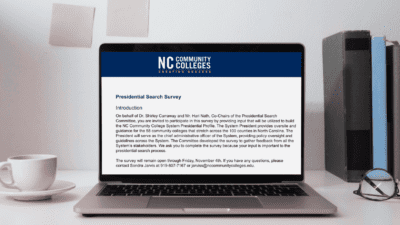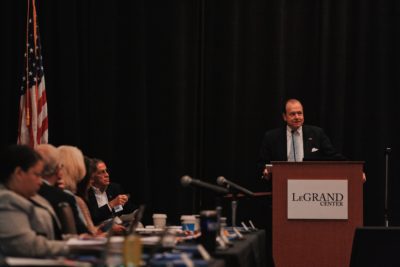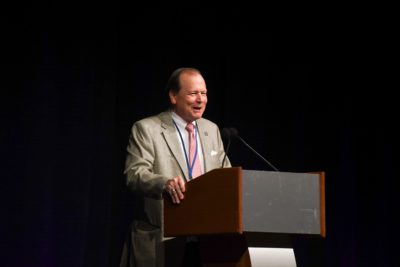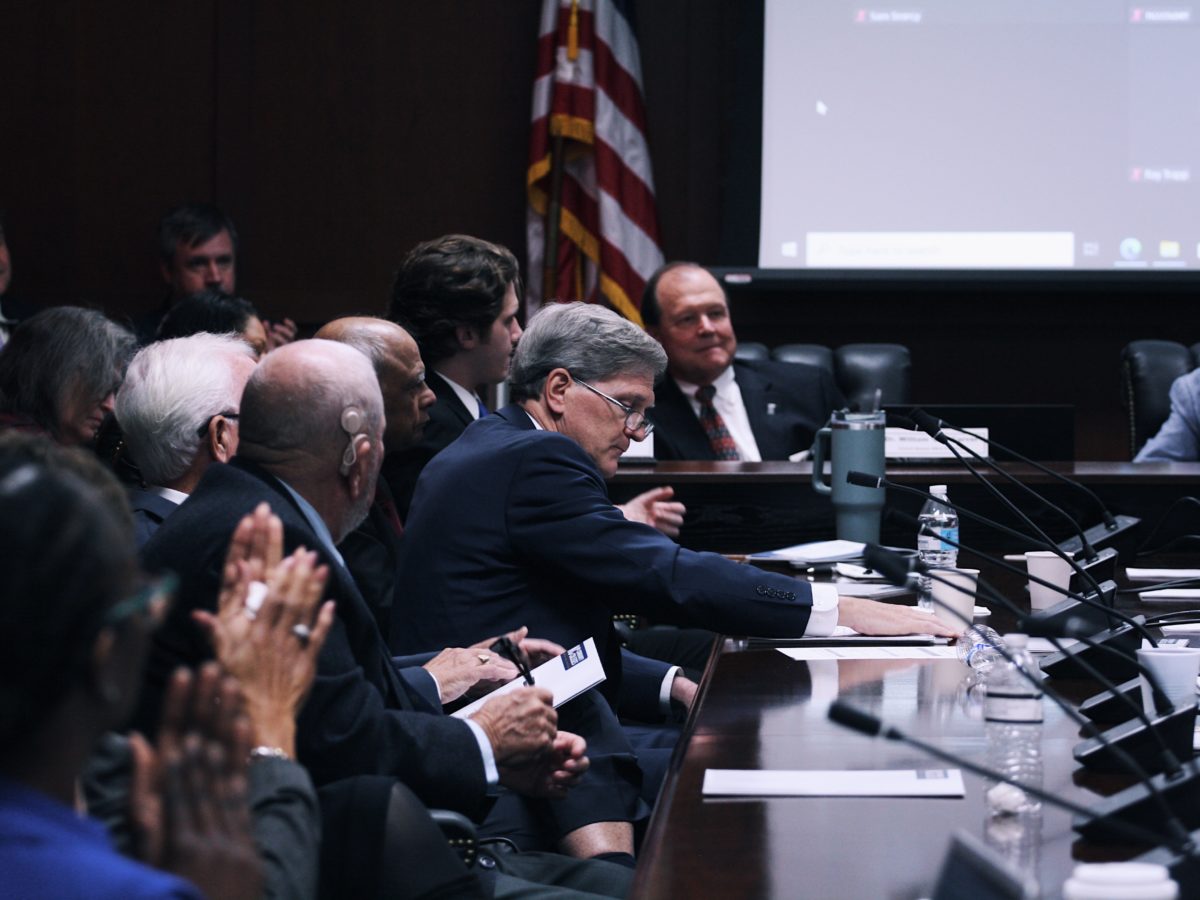

|
|
The North Carolina Community College System’s (NCCCS) new four-year strategic plan is finally complete — 13 months after the system embarked on the work.
The State Board of Community Colleges unanimously approved the 2022-2026 strategic plan, “Leading Through Change,” at its Oct. 21 meeting.
“Today’s a really good day when you step back from it,” Board member Mark Merritt said, noting the Board’s approval of the new strategic plan along with new bylaws and committee charters. “There are a lot of good things happening here — the direction of the arrow for the community college system is really pointing up. …I know we have our challenges ahead of us, but I just want to celebrate a good day.”
The new 40-page strategic plan includes objectives and strategies the Board will use to meet its five primary goals. The system will also use one-year action plans with specific action steps, timelines, and metrics to support implementation of those goals.
Strategic Planning Committee Chairperson Ann Whitford said they will start implementation of the new plan by communicating the goals to NCCCS stakeholders. The system will print approximately 500 copies, staff said, and share the digital file widely.
Then the Board must finalize the first one-year action plan. You can read more about the draft one-year plan presented in September here.


“While the plan is finished, our work has just begun,” Whitford told the Board.
The 2022-26 strategic plan outlines five goals for the system, with primary measures of success for each.
- Goal 1: Recruit and retain top talent to enable the North Carolina Community College System to educate and prepare the State’s workforce. Primary measures for this goal: Full-time faculty and staff salaries, full-time faculty demographics, and full-time faculty and staff institutional retention.
- Goal 2: Increase access and enrollment at North Carolina community colleges to meet the state’s educational attainment goal and expand postsecondary opportunities. Primary measures for this goal: Headcount student enrollment, high school dual enrollment, and full-time equivalent (FTE) enrollment, all disaggregated.
- Goal 3: Provide resources inside and outside the classroom for all students to successfully enroll, persist, and complete a career program of study. Primary measures of this goal: Curriculum course success comparisons across demographics, student curriculum persistence, credit-level math and English completion, and basic skills student progress.
- Goal 4: Provide education, training, and credentials to develop the most competitive workforce in the nation. Primary measures for this goal: total enrollment for Curriculum Career and Technical Education (CTE) and workforce continuing education, businesses and students served through economic development programs, and CTE graduate enrollment growth and earnings.
- Goal 5: Increase state funding, streamline the allocation formula, and implement practices to improve system effectiveness. Primary measures for this goal: legislative funding, program collaboration across colleges, students served through such collaboration (Instructional Service Agreements), student support investment (per FTE), and future surveys of system office services.
The plan also links to individual colleges’ strategic plans, a summary of findings from listening sessions with college presidents and trustees, and the North Carolina Comprehensive Community Colleges Student Government Association’s student survey and focus group findings.
“The past four years have revealed that no agency can forecast all the challenges or opportunities,” the new strategic plan reads. “This is a living plan that will be adjusted as needed. The system will continue to be the nimble, responsive, and innovative catalyst serving North Carolina’s students, businesses, and communities.”
Legislative funding request
Concerning Goal 5 and legislative funding, the Board also reviewed the second year of its FY 2022-2025 legislative agenda – which seeks an increase in state funding by $232 million over the next two years. Jason Hurst, president of Cleveland Community College, told the legislative committee that the N.C. Association of Community College Presidents “felt really compelled to stick with our three-year plan” developed last year.
“We felt like that will go a long way in building trust with our legislators. They’ve seen this plan – it hasn’t changed,” Hurst said. “If I’m not mistaken, if funded this will be the largest increase in the history of the two-year community college system. So this is a huge shot in the arm for the system should this be completely funded.”
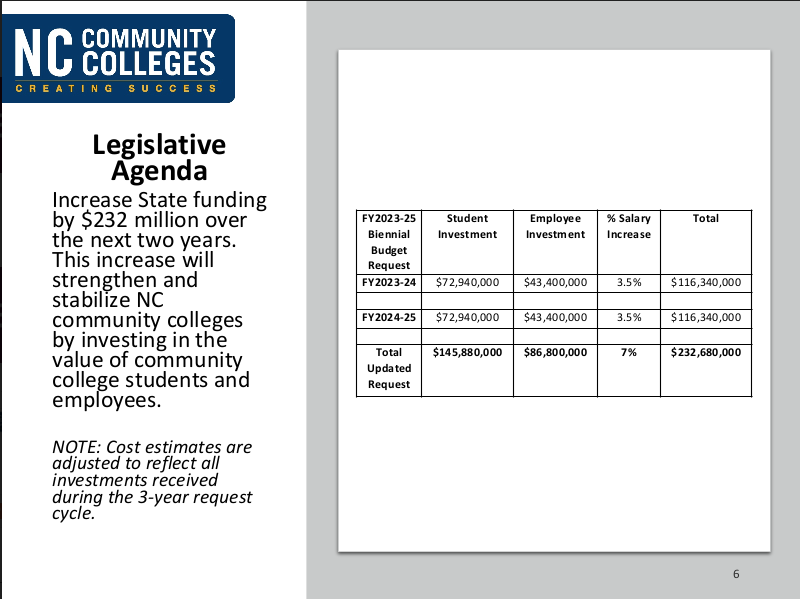

The requested increase is related to faculty salaries and student investment/capacity building. The document approved in January 2022 requested an additional 1% employee salary increase and a 4% increase for student investment in the 2022-23 short session. The community college system received the 1% employee salary increase in the budget passed by the legislature in early July but did not receive the 4% increase for student investment.
“This discussion will continue as we get closer to the long session,” Chair Burr Sullivan told the Board. “But we all need to be committed to staying the course on those two components to earn $232 million so we can expand our reach in the next two years.”
Governance updates
Board committee members also voted to approve their new charters last week, and the governance committee approved updated State Board bylaws. That committee continued review on an 88-page State Board handbook but did not approve a final draft.
The work to streamline governance structures is part of the Board’s three-year development and engagement plan. The Board approved recommendations for the plan in April based on the results of its first self-assessment survey.
Committees met virtually Aug. 26 through Sept. 1 to discuss changes to their charters, which they discussed in September. Some of those changes related to risk assessment and management in the audit committee’s charter, reserve funds language in the finance committee’s charter, and a new name for the programs committee — Programs and Student Success.
The full Board approved the charters last week with very minor edits.
You can view the updated charters here: Accountability and Audit, Finance, Legislative Affairs, Personnel, Planning, Policy and Governance, and Programs and Student Success.
“This is important work,” Merritt said in August. “We really need the best thinking of everybody on the Board with respect to updating our charters. We think this will be a very helpful step in our governance improvement process.”
Presidential search update
The Board’s presidential search committee also provided a brief update.
On Monday, Oct. 24, the committee met in closed session to discuss search firm evaluations, according to the agenda for the meeting. Prior to that meeting, the system launched a survey to gather stakeholder input on its search for a new president.
You can access the survey here through Nov. 4. The system will work with the State Board of Community College’s presidential search committee to analyze survey results by Nov. 14. The search committee will then meet Nov. 16 to continue work on its presidential profile ahead of the full Board’s regular meeting.
“Selecting a firm will have a critical impact on the search calendar and ultimately, on the speed at which we can acquire a new president,” Committee Chairperson Shirley Carraway said in September. “This is the beginning of this process.”
The presidential profile drafted by the search committee on Oct. 5 is a starting point for the search. The official profile for the search will include input from the survey and the vendor hired for the search.
The Board will host a virtual meeting the week of Nov. 7, Chair Sullivan said last week, to review the search committee’s vendor selection. The Board’s next regular meeting is Nov. 17-18.
Other meeting business
Member Ray Russell offered a reflection on this month’s mass shooting in Raleigh to start the meeting. He named each of the victims, one of whom – Mary Marshall – was a graduate from Wake Tech’s culinary program in 2014.
The Board received the annual report on the Comprehensive Articulation Agreement (CAA), an agreement between the 58 NCCCS colleges and the 16 constituent institutions of the UNC System. The CAA applies to all NCCCS students transferring to a UNC system institution who successfully complete a course that is designated as transferable or graduate with an associate in arts or associate in science degree.
The report noted a 4% decrease (423 students) in the number of NCCCS students transferring to the UNC System. In September, the UNC System announced a new database to help such students transfer across N.C. public institutions more easily. That online database, called the UNC Common Numbering System, includes over 1,600 undergraduate, lower-level courses from institutions within both the UNC and NCCCS systems.
The Board approved an allocation of $5 million to continue the Workforce Resilience Grant Program. That program will provide financial assistance equaling either up to $750 per course, or the total cost of the course fee(s) if the fee(s) exceed $750. Board members heard an update on economic development during the special issues luncheon on Thursday. Bruce Mack, vice president of economic development for the system, gave that presentation.
The system announced Nathan Hardin as the new NCCCS Executive Director of Communications, approved by the Board last week. This director will help with communication indicated in the new strategic plan, staff said. Hardin previously worked at Durham Technical Community College as the director for marketing and communications since the summer of 2017. The Board also approved Elbert Lassiter as interim president at Randolph Community College, who started as acting president in July.
The Board approved salary increases for several NCCCS employees: a 2% raise for Associate Vice President of Academic Programs Lisa Eads; 2% raise for Senior Vice President & Chief Financial Officer Brandy Andrews, 19% raise for Director of Government Relations Alex Fagg, and 21% raise for General Counsel Tawanda Artis.
The Board approved an updated definition for Hybrid Flexible (HyFlex) Instruction: “A multi-modal instructional delivery method where the college has the option to deliver the online portion of a curriculum course synchronously, asynchronously, or both as long as 100% of the instruction is offered face to face with the instructor in a physical classroom. Students may choose to attend the regularly scheduled in-person session or the online option on a session-by-session basis.” The Board approved a different definition in September.
The finance committee postponed a vote on Alamance Community College’s request for multi-campus center approval to next month. The committee asked the college to come back with more evidence regarding some of the criteria for that approval. In its consent agenda, the finance committee also approved $412,340 in continued support of a joint pilot project between Pamlico Community College and Pamlico Correctional Institution to reduce offender recidivism. The pilot project is expected to serve 60 students in FY 2022-23.
There is one vacancy on the Board following the resignation of William Holder in September. He expressed disappointment with Thomas Stith’s departure as president in July. His term was set to expire June 30, 2023.
Board members applauded the success of the system’s biennial conference Oct. 9-11. It was the first in-person gathering since 2018 and included over 200 concurrent sessions and various roundtable discussions throughout the three days.



